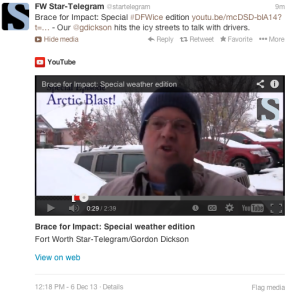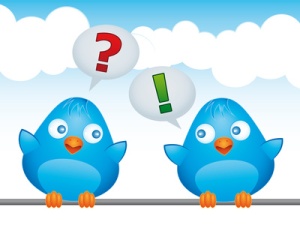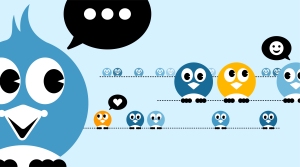If you’re not in the Dallas/Ft. Worth area, you don’t know that we’re currently under a Winter Storm Warning. We don’t get snow or ice very often in this part of Texas, but when we do, everything shuts down—government offices, transportation, schools, businesses. Everyone holes up until the weather passes.
When I was a college freshman in 2002, it meant no classes. It meant that I got to use my laundry hamper as a sled and spent the afternoon sliding down the frozen hillsides with my friends.
In 2010, it meant that I was cooped up in my one-bedroom apartment for four days by myself, while the business I worked for was closed. It meant that I watched as much “Gilmore Girls” as I could stomach and finally unpacked the last few boxes from my recent move.
Today as I look out at my snow-covered bushes, it means that I work from home. My home office is not closed for business. I’m still working. I still need to know what’s going on.
Thankfully, there are a lot of options, social media being one of the most abundant.
“Weather has always been one of the most social of topics. Everyone has their own way for predicting the weather, and of course, an opinion about what lies ahead. However, our ideal source of information is no longer limited to traditional news channels. People are curious, and want to know what the rest of the world is thinking…and especially during weather-related events. Everyone is equally keen to learn from local accounts and individual experiences,” said Deanna Lawrence of Social Media Today.
Colleges like the University of North Texas are sending out notices not to come to class or work during inclement weather. You don’t need to sit around the TV waiting for their school to come up on the alphabetized list, and if all Dallas/Ft. Worth schools, universities, businesses and churches are being included on the list, you could be waiting around a while.
There are even awards now for “The Best Weather in Social Media.” Texas Storm Chasers is 7th on the list.
One of the most recent examples of social media usage during a weather disaster was when Hurricane Sandy hit New York, New Jersey and other East Coast states last year.
“While Superstorm Sandy wreaked havoc along the East Coast late in October 2012, the power of sending real-time weather information and photos on social media was apparent. The sharing of information and pictures during hurricanes and other disasters helps to inform the public faster than ever before that there may be a weather danger,” said meteorologist Meghan Evans of AccuWeather.com
Don’t trust every Tweet or Facebook and Instagram photo, though.
“Social media users are transforming the information world, especially the growing legions armed with photo and video capabilities on their smartphones.
But inauthentic and/or manipulated images have emerged as a real problem. Fortunately, new tools are available to spot these fakes, and squash their propagation before they take on a life of their own,” said Ian Livingston of The Washington Post.
























